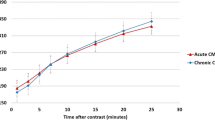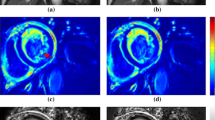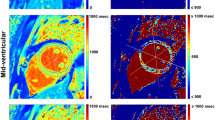Abstract
Purpose
Our aim was to evaluate the reliability of visual quantification of infarct extent on delayed enhanced magnetic resonance images.
Materials and methods
Eighty patients with previous myocardial infarction underwent cine and contrast-enhanced cardiac magnetic resonance imaging. The gadolinium-enhanced images were evaluated using a segmental model with two different methods: a visual score on a 5-point scale (0 no hyperenhancement, 4 hyperenhancement > 76% of myocardial wall) and a quantitative analysis based on the manual tracing of infarct contours with automatic threshold analysis. Each segment was also assigned a wall-motion score ranging from 0 (normokinesia) to 4 (dyskinesia). Statistical evaluation was performed.
Results
Out of 1,280 segments, 322 (25.1%) showed wall-motion abnormalities with enhancement in 327 (25.5%) evaluated with visual score and in 414 (32.3%) quantitatively. Among segments with normal or mild hypokinesia, 89.2% had a delayed-enhancement score ≤ 1, whereas 80.2% of akinetic or dyskinetic segments had a score ≥ 3. Mean time required for the visual and quantitative approach was 7±3 and 18±9 min, respectively. There was strong agreement between the visual and quantitative method (k=0.92; p<0.01).
Conclusions
Visual analysis of delayed enhancement is a timesaving approach that is sufficient to assess the transmural extent of infarction. Moreover, it has high correlation with wall-motion abnormalities.
Riassunto
Obiettivo
Valutare l’affidabilità della quantificazione visiva dell’estensione dell’infarto sulle immagini di delayed enhancement.
Materiali e metodi
Ottanta pazienti con precedente infarto sono stati sottoposti a risonanza magnetica cardiaca cine e con contrasto. Le immagini post-gadolinio sono state valutate utilizzando un modello segmentale con 2 metodi: uno score visuale con scala a 5 punti ( 0=assenza di enhancement, 4=enhancement > 76% della parete) ed un’analisi quantitativa disegnando manualmente l’area dell’infarto con correzione automatica dei contorni. Ad ogni segmento è stato assegnato uno score di contrattilità.
Risultati
Dei 1280 segmenti, 322 (25,1%) presentavano contrattilità alterata con enhancement in 327 (25,5%) valutati visivamente e in 414 (32,3%) quantitativamente. Tra i segmenti con normale o lieve ipocinesia l’89,2% aveva uno score di enhancement ≤ 1, mentre l’80,2% dei segmenti discinetici o acinetici aveva uno score ≥ 3. Il tempo necessario per la misura visuale e quantitativa è stato rispettivamente di 7 ± 3 e 18 ± 9 minuti. La concordanza fra analisi visuale e quantitativa è alta (k=0,92; p<0,01).
Conclusioni
L’analisi visuale del delayed enhancement è un approccio più rapido e sufficiente per definire l’estensione transmurale dell’infarto; inoltre ha un’alta correlazione con la disfunzione contrattile.
Similar content being viewed by others
References/Bibliografia
Mahrholdt H, Wagner A, Judd RM et al (2005) Delayed enhancement cardiovascular magnetic resonance assessment of non-ischaemic cardiomyopathies. Eur Heart J 26:1461–1474
Kim RJ, Fieno DS, Parrish TB et al (1999) Relationship of MRI delayed contrast enhancement to irreversible injury, infarct age, and contractile function. Circulation 100:1992–2002
Ramani K, Robert MJ, Holly TA et al (1998) Contrast magnetic resonance imaging in the assessment of myocardial viability in patients with stable coronary artery disease and left ventricular dysfunction. Circulation 98:2687–2694
Kim RJ, Chen EL, Lima J, Judd RM. (1996) Myocardial Gd-DTPA kinetics determine MRI contrast enhancement and reflect the extent and the severity of myocardial injury after acute and reperfused infarction. Circulation 15:3318–3326
Fedele F, Montesano T, Ferro-Luzzi C et al (1994) Identification of viable myocardium in patients with chronic artery disease and left ventriculardysfunction: role of magnetic resonance imaging. Am Heart J 128:484–489
Fieno DS, Kim RJ, Chen EL et al (2000) Contrast-enhanced magnetic resonance imaging of myocardium at risk: distinction between reversible and irreversible injury throughout infarct healing. J Am Coll Cardiol 36:1985–1991
Schuijf JD, Kaandorp TAM, Lamb HJ et al (2004) Quantification of myocardial infarct size and transmurality by contrast-enhanced magnetic resonance imaging in men. Am J Cardiol 94:284–288
Hsu LY, Natanzon A, Kellman P et al (2006) Quantitative myocardial infarction on delayed enhancement MRI. Part I: animal validation of an automated feature analysis and combined thresholding infarct sizing algorithm. J Magn Reson Imaging 23:298–308
Hsu LY, Ingkanisorn WP, Kellman P et al (2006) Quantitative myocardial infarction on delayed enhancement MRI. Part II: Clinical application of an automated feature analysis and combined thresholding infarct sizing algorithm. J Magn Reson Imaging 23:309–314
Cerqueira MD, Weissman NJ, Dilsizian V et al (2002) American Heart Association Writing Group on Myocardial Segmentation and Registration for Cardiac Imaging. Standardized myocardial segmentation and nomenclature for tomographic imaging of the heart: a statement for healthcare professionals from the Cardiac Imaging Committee of the Council on Clinical Cardiology of the American Heart Association. Circulation 105:539–542
Kim RJ, Wu E, Rafael A et al (2000) The use of contrast-enhanced magnetic resonance imaging to identify reversible myocardial dysfunction. N Engl J Med 343:1445–1453
Author information
Authors and Affiliations
Corresponding author
Rights and permissions
About this article
Cite this article
Ligabue, G., Fiocchi, F., Ferraresi, S. et al. How to quantify infarct size on delayed-enhancement MR images: a comparison between visual and quantitative approach. Radiol med 112, 959–968 (2007). https://doi.org/10.1007/s11547-007-0196-7
Received:
Accepted:
Published:
Issue Date:
DOI: https://doi.org/10.1007/s11547-007-0196-7




